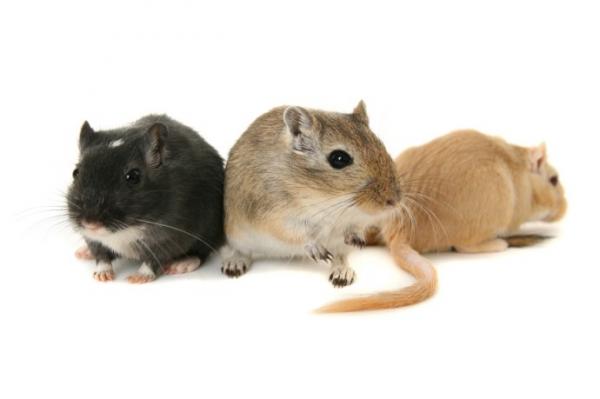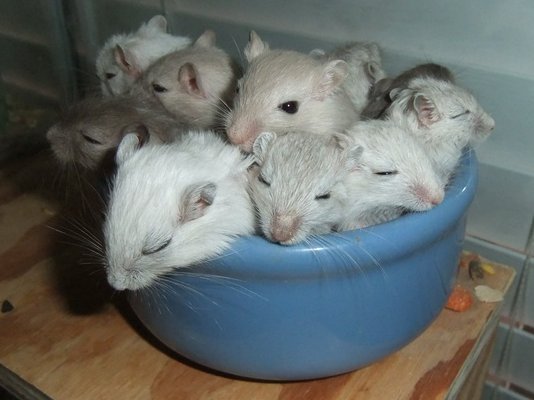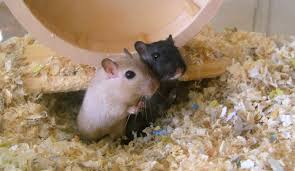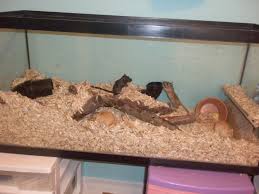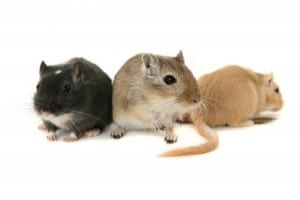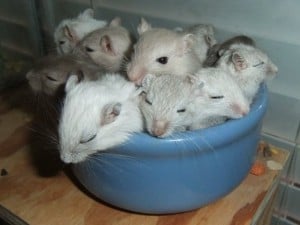Type the name of the breed you're looking for below
[wpdreams_ajaxsearchlite] Don't see the breed your're looking for? Click here and let us know!Gerbil
| Origin | A gerbil is a small mammal of the order Rodentia. Once known simply as "desert rats", the gerbil subfamily includes about 110 species of African, Indian, and Asian rodents, including sand rats and jirds, all of which are adapted to arid habitats. Most are primarily diurnal (though some, including the common household pet, do exhibit crepuscular behavior), and almost all are omnivorous. The word "gerbil" is a diminutive form of "jerboa", though the jerboas are an unrelated group of rodents occupying a similar ecological niche. Meriones unguiculatus evolved on the semi-deserts and steppes of Mongolia. There, they developed long legs for jumping and running from predators, teeth to deal with hard seeds and plant matter, and water conservation techniques that allow them to survive in the arid climate, such as the ability to use dry food or stores of fat to generate metabolic water. Mongolian gerbils do not have many natural enemies due to the harsh climate. Most predators are birds of prey or snakes. Mongolian gerbils are diurnal, but return to their burrows for the coldest and hottest parts of the day. |
| Natural Habitat | The species M. unguiculatus came originally from Mongolia. Its habitat there is mainly semideserts and steppes. Soil on the steppes is sandy and is covered with grasses, herbs, and shrubs. The steppes have cool, dry winters and hot summers. The temperature can get up to 50 °C (122 °F), but the average temperature for most of the year is around 20 °C (68 °F). In the wild, these gerbils live in groups generally consisting of one parental pair, the most recent litter, and a few older pups. Only the dominant female will produce pups, but she will mate with multiple males while in estrus (heat). One group of gerbils generally ranges over 325–1,550 square metres (0.08–0.38 acres). A group lives in a central burrow with 10–20 exits. Some deeper burrows with only one to three exits in their territory may exist. These deeper burrows are used to escape from predators when they are too far from the central burrow. A group's burrows often interconnect with other groups. |
| Wild Species | One Mongolian species, Meriones unguiculatus, also known as the clawed jird, is a gentle and hardy animal that has become a popular pet. It was first brought from China to Paris, France, in the 19th century, and became a popular house pet. Meriones unguiculatus, the Mongolian jird or Mongolian gerbil is a rodent belonging to subfamily Gerbillinae. It is the most widely known species of the gerbil subfamily, and is the usual gerbil species to be kept as a pet or experimental animal, when it is known as the domesticated gerbil. Like the Syrian or golden hamster, it was first brought to the United States in 1954 by Dr. Victor Schwentker for use in research. Forty-four pairs were caught in Mongolia and brought to England. They were described as "squirrel colours... with long furry tails." They are somewhat larger than mice, with a body about 12 cm long (and a tail of similar length), with body mass averaging 50-55 grams in females and 60 grams in males. Gerbils are typically between six and 12 inches (150 and 300 mm) long, including the tail, which makes up about one-half of their total length. One species, the great gerbil, or Rhombomys opimus, originally native to Turkmenistan, can grow to more than 16 inches (400 mm). The average adult gerbil weighs about 2.5 oz. (70 g). |
| History with Humans | The first known mention of gerbils came in 1866, by Father Armand David, who sent "yellow rats" to the Museum of Natural History (Musée d'Histoire Naturelle) in Paris, from northern China. They were named Meriones unguiculatus by the scientist Milne-Edwards in 1867. This scientific name in a combination of Greek and modified Latin loosely translates as "clawed warrior" in English, partly stemming from the Greek warrior Meriones in Homer's Iliad, combined with 'unguiculate' meaning to have claws or nails. Gerbils only became popular pets after 1954, when 20 breeding pairs were brought to the United States from eastern Mongolia for scientific testing. Almost all pet gerbils today are descended from these 40. Gerbils were brought to the United Kingdom in 1964 from the United States. |
| As Pets | Gerbils were first introduced to the pet industry in 1964. These were the Mongolian gerbils. Their value as pets was soon appreciated and they are now found in pet shops all over the UK and USA. Due to the threat they pose to indigenous ecosystems and existing agricultural operations, it is illegal to purchase, import, or keep a gerbil as Gerbils as pets The Mongolian gerbil, a gentle and hardy animal, has become a popular pet. It was first brought from China to Paris, France in the 19th century, and became a popular house pet. It was then brought to the United States in 1954 by Dr. Victor Schwentker for use in research. Selective breeding for the pet trade has resulted in a wide range of different color and pattern varieties. The Mongolian gerbil is classed as a "prohibited new organism" under New Zealand's Hazardous Substances and New Organisms Act 1996, preventing it from being imported into the country. The several reasons for the popularity of gerbils as household pets include: The animals are typically not aggressive, and they rarely bite unprovoked or without stress. They are small and easy to handle, since they are sociable creatures that enjoy the company of humans and other gerbils. Gerbils also have adapted their kidneys to produce a minimum of waste to conserve body fluids, which makes them very clean with little odor. Many colour varieties of gerbils are available in pet shops today, generally the result of years of selective breeding. Over 20 different coat colours occur in the Mongolian gerbil, which has been captive-bred the longest. Another species of gerbil has also been recently introduced to the pet industry: the fat-tailed gerbil, or duprasi. They are smaller than the common Mongolian gerbils, and have long, soft coats and short, fat tails, appearing more like a hamster. The variation on the normal duprasi coat is more gray in colour, which may be a mutation, or it may be the result of hybrids between the Egyptian and Algerian subspecies of duprasi. White spotting has been reported in not only the Mongolian gerbil, but also the pallid gerbil and possibly Sundervall's Jird. A long-haired mutation, a grey agouti or chinchilla mutation, white spotting, and possibly a dilute mutation have also appeared in Shaw's jirds,and white spotting and a dilute mutation have shown up in Bushy-tailed Jirds. |
| Colour Variations | Golden Agouti — All Mongolian Gerbils in the wild are Golden Agouti, also called Agouti. The hair shafts on the back are grey at the base, gold in the middle and tipped with black, making an even mix of golden brown with black ticking. The belly is creamy white. An Agouti gerbil has black eyes. Black — A Black gerbil is black both on its back and on its belly. It most often has a "bib" or white line running down its chin. It also may have some white on its paws. A Black gerbil has black eyes. Black gerbils are also known to have a white belly. Argente — An Argente gerbil is orange with a white belly. It has deep ruby eyes. If one were to brush back the fur on its back, one would see that the roots are grey. Argente Cream — An Argente Cream gerbil is an Argente lightened by a Himalayan gene, c(h). It is light orange with a white belly and ruby eyes. The undercoat is grey like the Argente Gold, but diluted due to the c(h). Argente Fawn / Topaz — A Topaz gerbil is an Argente lightened by a gene called Chinchilla Medium, c(chm), formerly called Burmese, c(b). This colour is lighter than an Argente Golden but darker than an Argente Cream, and it often has slightly darker points at the ears, nose and tail. It has ruby eyes. The undercoat is grey, but diluted due to the c(chm). Lilac — A Lilac gerbil is dark grey all over. It has ruby eyes. Dove — A Dove gerbil is a Lilac lightened by the Himalayan gene, c(h). It is a powdery light grey all over. It has ruby eyes. Sapphire — A Sapphire gerbil is a Lilac lightened by a gene called Chinchilla Medium, c(chm). This colour is lighter than a Lilac but darker than a Dove. It has ruby eyes. Pink-eyed White — A Pink-eyed White gerbil is completely white with light ruby eyes. Burmese / Colourpoint Black — A Colourpoint black gerbil is an all over chocolate colour. Around eight weeks or so, it will begin to develop darker points on the tail, nose, feet and tips of the ear. Often has a "bib" or white line running down the chin. It also may have some white on its paws. All Burmese gerbils have black eyes. Siamese / Light Colourpoint Black — A Siamese gerbil starts out a light mushroom colour. Around eight weeks, it molts and the tail, nose, feet and tips of the ear go black. The main body colour stays the same. A Siamese has black eyes. It also often has a "bib" or white line running down the chin. May also have some white on the paws. Younger Siamese gerbils can have lighter bands on their feet, but will fade on the back but may stay on the front. Their colour is also described as "Mushroom colourpoint". Colourpoint Agouti — A Colourpoint Agouti has an off-white to grey base with a liberal amount of silvery-brownish ticking along the back. The belly is white and the eyes are black. Light Colourpoint Agouti — A Light Colourpoint Agouti has an off-white base with silvery-brownish ticking along the back. Its belly is white and its eyes are black. Grey Agouti — The hairs on the back of a Grey Agouti are dark grey with white in the middle, making an even salt-and-pepper look. They often have gold intermingled into the coat. The belly is white. Grey Agoutis have black eyes. Slate — A Slate gerbil is a greyish black colour. Often has a "bib" or white line running down the chin. It may also have some white on the paws. A Slate has black eyes with a reddish reflective shine in bright light or flash, however this can also appear on Black gerbils with certain recessives i.e. c(chm). Ivory Cream — An Ivory Cream gerbil is creamy coloured on its back with a light cream belly. It has ruby eyes. Ruby-Eyed White — A Ruby-Eyed White gerbil is white all over. It has ruby eyes. Also known as Red Eyed White. Dark Eyed Honey — A Dark Eyed Honey gerbil starts out with a bright orange back with a white belly and flanks. At 8 weeks it molts and a small amount of black ticking appears along its back. A Dark Eyed Honey has black eyes. Nutmeg — A Nutmeg gerbil starts out with a bright orange colour over its entire body. At 8 weeks it molts and liberal black ticking appears along the back with a lesser amount on the belly, changing the colour from an orangey-brown to almost pure black, depending on the extensiveness of the ticking. A Nutmeg gerbil has black eyes. Silver Nutmeg — A Silver Nutmeg gerbil's first coat is an ivory colour. At 8 weeks the gerbil molts and the liberal greyish ticking appears along the back with a lesser amount on the belly. A Silver Nutmeg gerbil has black eyes. Red Eyed Honey / Yellow Fox — A Yellow Fox gerbil has a bright orange back with a white belly and flanks. It has ruby eyes. Saffron / Red Fox — A Red Fox is a bright orange colour over its entire body, with the colour lightening somewhat through the belly area. Often there is a "bib" or white line running down the chin. There may also be some white on the paws. A Red Fox has ruby eyes. Polar Fox — A Polar Fox starts out a creamy ivory colour. At 8 weeks the gerbil molts and minimal greyish ticking appears along the back. The nails are clear. A Polar Fox has black eyes. Schimmel — A Schimmel gerbil starts out as an orange colour. At eight weeks old it molts and the coat begins to lighten to a creamy white. The gerbil's body continues to lighten throughout its life until it can be left with a white body, while the tail, nose, feet and tips of the ears retain the orange. Schimmel gerbils have black eyes. A schimmel with ruby eyes is a Ruby Eyed Schimmel. Black Eyed White — A Black Eyed White gerbil is completely white with black eyes. Some have greyish ear tips and dark claws. Spotting - Dominant spotting can be in any coat variety and will lighten the fur around it. How the spotting will look depends on modifiers. Collared - A thick, unbroken band of spotting around the neck connecting to the white belly. Collar and blaze - A thick, unbroken band of spotting around the neck connecting to the white belly and an unbroken white blaze connecting the three spotting areas (neck, forehead and nose). |
| Care | Toys and Exercise: Gerbils are very active animals, and they need an entertaining environment. Let your imagination be your guide. A four by four makes a great toy. Have several large holes drilled through it. Ask whether the lumberyard will do the cutting and drilling for you. They are also cheap, as you can use scrap pieces. This will provide the gerbils with entertainment and a great chew toy. Be sure that the lumber is not treated! Special wooden play/chew toys can be purchase at pet stores in the shape of cheese wedges or treasure chests. Every time you finish off a roll of toilet paper add it to the aquarium. The gerbils will run in and out of the tube before settling down to a good gnaw. They love it, but within a few hours it will be shredded. For those having multiple tanks, you might find yourself getting these from family, friends, co-workers…anywhere you can to keep your gerbils "in cardboard". Heavier cardboard boxes work well to climb on and nest in and will last longer. You can use traditional wire hamster wheel in your aquariums, but there are several precautions that must be taken before using them with your gerbil. First, to save on room hang the wheels from the wire tank lid. This keeps it three to four inches off the tank floor. A simple way to attach the wheel to the tank lid is by using twist ties. They work well, and are easily removed. Second, tightly cover the outside of the wheel with a heavy masking tape (but not plastic or anything with embedded threads). Then carefully coat the inside of the wheel with bedding. This covers up the tape, and prevents the gerbil's feet from sticking. Some gerbils love their wheel, and play in it for hours! Others are will have nothing to do with the wheel. |
| Bath Requirements | Grooming is not only a way to keeps clean, but also it is a vital part of the social infrastructure of gerbils. Pairs, parents, and pups will spend a lot of time each day grooming each other. Regular daily grooming is a sign that all is well in the family group. |
| Housing | A common misunderstanding when purchasing a home for pet gerbils is they can live in housing designed for hamsters and mice. This is not correct, as they need to be able to dig tunnel systems, rather than have them created for them. The commonly plastic structure of hamster and mouse cages is inappropriate for gerbils due to their ability to gnaw through it very quickly. Plastic can cause serious health issues for the animal if ingested, therefore many owners refrain from having any plastic in the tank and rely entirely on wooden toys. Information from gerbil societies from throughout the globe is conflicting with regards to tank sizing. However, a common minimum given appears to be 10 imperial gallons per gerbil. |
| Health | Trauma: Common injuries are caused by gerbils being dropped or falling, often while inside of a hamster ball, which can cause broken limbs or a fractured spine (for which there is no cure). Neglect: A common problem for all small rodents is neglect, which can cause the gerbils to not receive adequate food and water, causing serious health concerns, including dehydration, starvation, stomach ulcers, eating of bedding material, and cannibalism. Epilepsy: Between 20 and 50% of all pet gerbils have the seizure disorder epilepsy. The seizures are thought to be caused by fright, handling, or a new environment. The attacks can be mild to severe, but do not typically appear to have any long-term effects, except for rare cases where death results from very severe seizures. A way to prevent a gerbil from having a seizure is to refrain from blowing in the animal's face (often used to "train" the pet not to bite). This technique is used in a lab environment to induce seizures for medical research. Tumors: Tumors, both benign and malignant, are fairly common in pet gerbils, and are most common in females over the age of two. Usually, the tumors involve the ovaries, causing an extended abdomen, or the skin, with tumors most often developing around the ears, feet, mid-abdomen, and base of the tail, appearing as a lump or abscess. The scent gland (positioned on the abdomen) should be checked regularly; a veterinarian can operate on the lump where possible. Mating: Gerbils will mate for several hours, in frequent short bursts followed by short chases, when the female allows the male to catch her. Once he catches her, the female will squeak and make flick motions to get the male off her. Males will not attack females except in rare circumstances, which may also include them having been separated from their original mates, or widowed. A female may attack a male, but usually he is more than a match for her. |
| Diet | A good premixed gerbil food is recommended. It is easy to get the right combination of protein, minerals, vitamins, and bulk. Sunflower seeds tend to be very high in fat, and, therefore, are fattening. A good idea is to pick out the sunflower seeds and hand feed them to your gerbils over the course of the day. This has a double benefit. First, no one gerbil hoards them and gets too fat. Second, it is an excellent way to hand tame and bond with your gerbils. Food can be placed directly on the bedding in the center of the tank allowing the gerbils to forage. Food can also be served in small ceramic dishes sold at stores, or made out of small cat food or tuna cans. Most gerbils will bury their food dish in their bedding. This is their way of protecting it from other gerbils. Don't worry they will be able to find it with no problem. If you want to give your gerbils a treat, try things like Cheerios and Rice Krispies cereals (nothing with artificial flavor, sugar, or marshmallow). They also enjoy the occasional peanut, but those are very fatty. They also like an apple, carrot, and lettuce, but remove it after one day and don't give it to them too often. You might want to give a large piece (say half an apple) to gnaw on for a few hours then remove it. Small pieces can get lost in the bedding and rot. Food Dish: A food dish is not necessary because the gerbils will just bury it under their bedding. If you would prefer one, use a small heavy ceramic dish, so they can't tip it over as easily. |
| Dentistry | Misalignment of incisors due to injury or malnutrition may result in overgrowth, which can cause injury to the roof of the mouth. Symptoms include a dropped or loss of appetite, drooling, weight loss, or foul breath. The teeth must be clipped by a veterinarian regularly for as long as required. |
| Infectious Diseases | Tyzzer's disease The most common infectious disease in gerbils is Tyzzer's disease, a bacterial disease, which stress can make animals more susceptible to. It produces symptoms such as ruffled fur, lethargy, hunched posture, poor appetite, diarrhoea, and often death. It quickly spreads between gerbils in close contact. |
| Mental Health | Gerbils are highly social and do not like being alone at all, not like the solitary Syrian hamster. If you're getting gerbils you must get at least two. Lone gerbils have been proven to live shorter, less healthy lives, and are often overweight and not too happy. They also tend to be harder to tame and less friendly overall. Even if you are home all day, and playing with them constantly, this does not make up for the fact that they must sleep alone, eat alone, and have no one to groom them. So a companion is essential. Both females and males will get along happily with a companion of the same sex, especially if they are siblings or kept together from the age of six to eight weeks old. Females tend to be less stable in groups larger than two, while males tend to be more tolerant of each other in groups of three, or more. However, it is recommended that the average gerbil owner stick to a pair of gerbils, as the chance of fighting increases with larger groups. |

